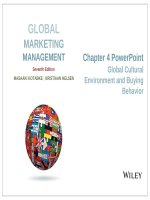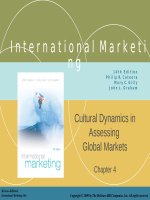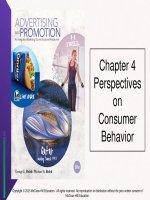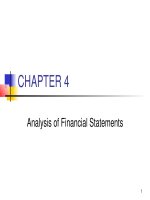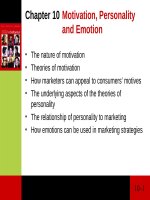Lecture Consumer behaviour: Chapter 4 - Cathy Neal, Pascale Quester, Del Hawkins
Bạn đang xem bản rút gọn của tài liệu. Xem và tải ngay bản đầy đủ của tài liệu tại đây (1.24 MB, 27 trang )
Chapter 4 Information Search
• Nature of information search
• Key types and sources of information
• The difference between evoked, inept and inert
•
•
•
•
sets of brands
Why consumers engage in information search
How the Internet is used as an information source
Factors that affect the amount of external
information search
What marketing strategies can be developed based
on different patterns of search behaviour
Copyright ª 2004 McGrawHill Australia Pty Ltd
4–1
Information Search
• Internal search versus external search
• Ongoing search or exploratory research
Copyright ª 2004 McGrawHill Australia Pty Ltd
4–2
Suggesting Evaluative Criteria that Match the
Brand’s Strengths
4–3
Information Search in Consumer
Decisions
4–4
Brands in Initial Awareness Set
4–5
Categories of Decision Alternatives
4–6
Awareness and Evoked Sets for Various Products
4–7
Information Sources
Impersonal
Personal
Commercial
Advertising,
information
Salespeople
Noncommercial
General purpose
media
Social others
Copyright ª 2004 McGrawHill Australia Pty Ltd
4–8
Information Sources for a Purchase Decision
4–9
Sources of Information for Services
4–10
Information Search on the Internet
•
•
2002 survey—half of Australian population online
Most important reasons for ‘surfing’ were:
‘to look for information’ (40%)
– ‘leisure’ (19%)
– ’to shop’ (18%)
–
•
•
•
Internet is the most popular information source for students
(2003 survey)
Over half of e-shoppers are women, taking over from males
73% of those with Internet at work use it every morning
Copyright ª 2004 McGrawHill Australia Pty Ltd
4–11
Marketing Strategy and Information
Search on the Internet
• Companies need to ask:
–
Should we have a web site?
–
What is the purpose of the site to be?
Information only
Company and product/service information
To actively attract customers
A shopping site
Copyright ª 2004 McGrawHill Australia Pty Ltd
4–12
The Amount of External
Information Search
• Measures used
–
–
–
–
No. of stores visited
No. of alternatives considered
No. of personal sources used
Overall or combination measures
Copyright ª 2004 McGrawHill Australia Pty Ltd
4–13
Classification of Searchers
• Non-searchers
• Limited information searchers
• Extended information searchers
Copyright ª 2004 McGrawHill Australia Pty Ltd
4–14
Amount of External Search for
Appliances
4–15
Information Sources used to Select
Professional Services
4–16
Information Searching Behaviour
4–17
Costs vs Benefits of External Search
4–18
Factors Affecting External Search
4–19
Factors Affecting External Search (cont.)
4–20
Factors Affecting External Search (cont.)
4–21
Factors Affecting External Search (cont.)
4–22
Marketing Strategies Based on
Information-Search Patterns
4–23
Strategies (in Evoked Set)
• Maintenance strategy
–
–
Defend against disruptive tactics
Constant activity + interest
• Capture strategy
–
–
Constant supply + quality
Continue limited search
• Preference strategy
–
–
–
Search locations must be anticipated, e.g. Chemists
POP + sales assistance
Know where they search
Copyright ª 2004 McGrawHill Australia Pty Ltd
4–24
Strategies (not in Evoked Set)
• Disrupt strategy
–
–
Attention-seeking ads
Free samples or bonus encouraging trial
• Intercept strategy
–
–
–
Must attract attention
POP display
Product improvements, etc.
• Acceptance strategy
–
–
Advertise but don’t ‘sell’ the brand
Encourage consumer to seek information
Copyright ª 2004 McGrawHill Australia Pty Ltd
4–25



